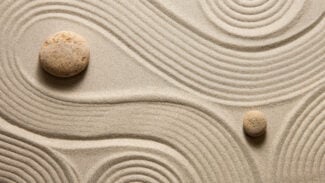Hello Wonder Woman,
You’re exhausted, you’re bloated, your face is greasy, your tummy is cramping, your head is pounding, your back is breaking, you’re sad then mad then super-smiley and all the chocolate and potato chips in the world couldn’t satisfy you. You’re “PMSing.” It’s that lovely period before…your period…when hormones are going haywire and you feel like a completely different version of yourself. A version you might not be fond of.
PMS, or Premenstrual Syndrome, is common, but confusing: Some women don’t get it at all, some get it full-force; sometimes it lasts 2 days, sometimes it lasts 10. Though the female reproductive system isn’t completely understood, researchers—and women around the world—have made a lot of progress in understanding what makes PMS more tolerable. Below, are some of the top natural remedies (nutrition and lifestyle tips) that will help you lessen your PMS woes—and maybe even eliminate them completely. But before we get to those goodies, let’s cover some PMS basics.
What is Premenstrual Syndrome (PMS)?
PMS—which some jokesters say stands for “Perpetual Munching Syndrome” or “Psychotic Mood Shift” or “Puffy Mid-Section”—usually shows up the week before Aunt Flo and can bring with it a laundry list of unpleasant symptoms (see above). A lot of these annoyances can be blamed on dropping estrogen and progesterone levels, which is typical for a woman to experience right before her period. In order to reduce PMS symptoms, we want to keep hormone levels at a moderately low, healthier level all month long (buh-bye dramatic dip!). Keep in mind that we don’t want your levels dipping too low—too little estrogen and progesterone can lead to other health challenges. My tips below are geared toward helping you find the right balance.
Top 5 Natural Remedies for Reducing PMS Symptoms
1. Be smart about dietary fats, and make them count. All dietary fats increase estrogen production (study). And since we’re trying to keep levels lower all month long to reduce the PMS dip, it’s a good idea to keep daily overall fat intake in check. Also try to emphasize Omega-3 fats the most in your diet (sources: flax, chia, hemp and walnuts). Omega-3s are not only anti-inflammatory and heart-healthy, but they have been shown to reduce many physical and psychiatric symptoms of PMS when 2,000 mg were consumed daily (study). Since the saturated fats in meats, fish and dairy products tend to drive estrogen production to a greater degree than vegetable fats (due to greater concentrations), you’ll find that following a more plant-based diet makes it easier to support hormonal balance throughout the month.
2. Get more fiber from whole plant foods. Fiber does the opposite of fat when it comes to female hormones, helping to keep levels in a healthy, lower place throughout the month (study). Eating lots of whole plant foods can ensure you’re getting the fiber your body needs for ideal hormone levels, better digestion, a powerful immune system and lower breast cancer risk (study). Aim for 5+ servings of veggies, 3+ servings of high-fiber, low-sugar fruits, plus a cup of cooked beans or lentils every day. Added bonus: Switching out low-fiber animal proteins for high-fiber plant sources like beans, lentils, tempeh, quinoa and hemp seeds packs a 1-2 punch of reducing saturated fats while bumping up fiber intake. Win!
3. Seek out calcium and vitamin D. Because blood levels of calcium and vitamin D have been shown to be lower in women with PMS, researchers studied these nutrients as potential PMS remedies in a subgroup of the Nurses’ Health Study II (a NIH-funded, Harvard-based research study of over 116,000 nurses, which investigated oral contraceptives, diet and lifestyle). They found that higher intake of both nutrients was associated with reduced chances of experiencing PMS (study).
The best plant sources of calcium include fortified non-dairy milks (e.g., hemp, flax and nut milks), kale, chia seeds, collards and tahini. Sunshine is the richest source of vitamin D, but if your latitude doesn’t allow you to get enough during darker times of the year, you can try food sources like dried shiitake mushrooms, fortified plant milks, orange juice and cereal. When it comes to supplements, Vitamin D2 or lichen-sourced D3 are your vegan options. Unfortunately, I can’t give you a definitive answer as to whether vitamin D2 or lichen-sourced D3 is as usable by the body as animal-based vitamin D3. For more info on plant-based vs. animal-based vitamin D, check out this Vegetarian Resource Group article.
4. Increase your intake of magnesium and vitamin B6. A combination of magnesium (250 mg) and vitamin B6 (40 mg) has been shown to significantly decrease PMS symptoms (study). Supplements (as opposed to foods) were used in most studies, but magnesium-rich grub can easily meet the recommended 250 milligrams that helps diminish PMS. If for some reason you need to supplement, look for magnesium citrate, which is the most easily absorbed. Keep in mind that although magnesium toxicity from foods is incredibly rare (the kidneys eliminate excess in the urine), magnesium supplements may cause toxicity symptoms such as nausea, abdominal cramping and diarrhea, or even more serious complications in high doses. The tolerable upper limit has been set at 350 mg per day.
As for vitamin B6, you probably will need to supplement. Food sources (sweet potatoes, white potatoes, sunflower seeds, spinach, bananas) only provide about 30% of the recommended 1.7 mg that can relieve moodiness, irritability, forgetfulness, bloating and anxiety (study). Important: If taking B6 supplements, be sure to not exceed the tolerable upper limit of 100 mg per day. Excessive doses may cause ataxia, which is a sensory neuropathy where you cannot control bodily movements (source). No bueno! If you think there’s any chance you’re nearing that upper limit, you may wanna get your levels checked by your doc, toots.










Hi Kris, thanks for publishing this, but I’m confused about the lowering of saturated fats. I just finished watching Dr. Mark Hyman’s fat summit (and Dr. Northrop was a speaker) and they say an overall plant based diet with 20% saturated fats are good for you. But it looks like here you’re saying avoid them?? Thanks for the feedback
Great question, Erika. I double checked the following with our Crazy Sexy RD, Jen, and I hope it helps clarify: All saturated fats are not created equal. Since the saturated fats in meats and dairy—mainly palmitic and myristic acids—are the ones that tend to cause the greatest health problems, I recommend opting for the saturated fats found in whole plant foods (not french fries!). So when it comes to hormonal balance, the take-home message is not necessarily to eat fewer saturated fats from plant foods, but to eat a more plant-based diet moderate in total fat. This approach will help you avoid that big dip in hormones I mention in the blog and help you maintain a healthy hormonal balance throughout the month. xo, kc
Hi Kris – thanks for these tips. I’ve been struggling with these issues for a while so I’m going to up my supplements and see if that helps. I’m already eating a fair bit of omega 3s and fiber.
Hi, I noticed that any fat or processed foods gave me cramps, even bottled water. It’s best that you keep a food diary and see what gives you cramps. I used to get cramps up until the 3-4th day of me period. Now only 1-2 days, as far as the other symptoms, when I eat as raw as possible, exercise and drink lots of water my symptoms were drastically reduced. I felt alive during my period with only needing one day of resting.
Thank you so much for posting these, Kris!!!! You are awesome!!! Our families thank you too! : )
Thanks, Danielle. xo! kc
I love the different names for PMS, I haven’t heard of them before (I’m not a native English speaker) – a good one I’ve seen somewhere was “Please Meet Satan” 😀
Sigh… I do basically everything you state above. I eat only clean organic/locally grown food, mainly plant based diet, eat meat a few times a month (MAYBE), raw cheese (and only raw) a few times a month (MAYBE), Omega-3 fat foods you state above are a staple in my diet, eat TONS of Chorollea and Spirulina EVERYDAY (this has ALL my B’s I need), vitamin D3 5000IU’s, Hot Yoga 4 times a week, plus many other healthy habits. I do take fish oil pills… maybe this is it. But my PMS is the poops. My breasts get so much heavier my boyfriend even notices the difference in size and weight, my tummy blots, my moods are all over the place, I dream less because I am more tired, I break out A LOT, and the cramps on the first blood day usually make me lay in bed for hours…. This usually starts about 7-10 days before I start bleeding making my period like a 11-15 day monthly ordeal… I need to fix this….
Good article though. I hope it helps out someone else 🙂 Maybe I am still detoxing from the dumb 12 years of my life taking birth control pills but I did stop 2 and a half years ago. I need to visit my naturopath.
Wish you the best in health,
Beans 🙂
Hi, Beans.
A few years ago, I read Dr. Fuhrman’s book, Eat to Live. I have been a mostly vegetarian/occasional pescetarian ever since but, for about three months, I ate completely vegan–strictly adhering to Fuhrman’s guidelines. During those few months, I easily lost 30 lbs, and my PMS symptoms went away completely. I felt amazing! He said something about fish oil, I wish I could remember what, that actually made me stop taking it. You might check your local library to see if it’s of any interest to you.
Another thing that I’ve found is an essential oil blend called DigestZen. I just rub some across my tummy when I’m having cramps, and it helps.
At any rate, I wish you well, and I hope you are able to find a blissful balance.
I stopped taking birth control in July 2015 after being on it for 16 years! Prior to going on the pill I used to get absolutely horrible cramps (so much pain I couldn’t even sleep), heavy periods, breakouts, and terrible migraines. Even when on the pill I still got migraines related to my cycle. When I stopped taking the pill, I was terrified that bad PMS symptoms would return. After doing quite a bit of research online and talking to my naturopath, I added two supplements: DIM Detox by Pure Encapsulations, and MacaHarmony. Since stopping the pill and taking these supplements, I have not had any issues with weight gain, no headaches, and only very mild cramps and bloating. I’ve had a few instances of PMS cravings, but after a day of binging on chocolate and chips I get things back under control 🙂 I should also note I’ve only had one actual period since I stopped taking the pill, though I’ve had other times where I feel like I’m going to get a period (and experience mild PMS symptoms) but my naturopath says that is normal for someone like me who was on the pill for a number of years & it will take time for my cycle to normalize so I’m not worried. I definitely give credit to the two supplements I mentioned for easing my transition off the pill, so you might want to check them out. I’ve also heard clary sage oil is good for cramps, though I haven’t had occasion to try it yet.
Thank you Kris, I love this info! I’ve recently pinpointed my main PMS problem child: hormone headaches. Grrr. I had learned that pumpkin seeds and seed butter (tahini, sunflower seed butter) are a good source of magnesium and can therefore help menstrual/hormonal headaches. I love understanding the power of food!
This is my favourite article you’ve ever written. What helps me deal? All of the above, but it’s taken me a long time to figure out, and having these handy tips right at my fingertips is going to be awesome. As always, the journey through has helped me to understand myself and to give me more empathy for other women, but PMS is not a gift I want to keep on giving! xxx
So happy to hear it, Sonia! xo
Kris I absolutely adore you and all of your advice! I only have one question. How can I get my taste buds used to all this healthy food? I tried some of the teas and juices and my taste buds totally resisted. I love sweet foods and carbs and when I don’t have them I crave them. I really do want to start eating healthier and I am willing to make some big changes in my life to do so. But I have to like what I eat does this make sense? Thank you!
Hi Christy,
I totally understand where you’re coming from. I went through the same thing when I had to change over to a gluten free dairy free vegetarian diet due to allergies. I tried juicing and wanted to spit it out because it was like drinking grass. I found starting off with a mix of fruit and veggies and recipes marked “kid approved” helped me get into it. You can also try starting with really mild tasting veggies like cucumber or lettuce. Sweet veggies like carrots help make the transition as well. Your palate does adjust with time and what you used to crave starts tasting disgustingly sweet. Start with maybe 75% fruits and 25% veggies and try and increase your veggies bit by bit. Also recognize that craving all those sweets and carbs means your body needs to detox. You will need to go through a phase of cutting them out and bearing the icky cravings. It’s hard, but so worth it! Give yourself time to adjust and have faith in yourself. I know you can do it! Just remember you’re worth it!!
Hi i have recently started taking 3 evening primrose capsule and 1 vitamin b6 and i had my first ever month of reduced pain and less pms. I am nearly due again so I am looking forward to seeing what happens this month
Magnesium helps me a lot. I take Natural Calm every night before bed and not only does it help me relax, it has definitely helped my pms. And plenty of healthy fats helps too!
Hi Kris, I love you! Quick question. Are dandelion greens also known as Rocket or Arugula? If so, those have a bit of a bitter, peppery taste and I’m wondering if you get used to that, or you can’t taste it in your smoothie. Thank you 🙂
I don’t think dandelion greens are the same as arugula/rocket, but they are a stronger-tasting green. If you’re just getting started, you may want to start with a milder green (spinach, romaine). Love ya too! kc
Thank you! I’ve been doing green smoothies for a couple years with spinach and kale, and I tried arugula in there today and it was biiitttterrrrr. Figured I would check because I want to reap the benefits of dandelion! Thank you XO
Hi Vanessa!!
Arugula can be strong but here’s a smoothie my 4yo son looooves… Arugula+ red grapes+ 1 frozen banana + ground flax blended with coconut water or plain water. The arugula still comes through but it’s not overpowering:)
Great info…thanks so much for sharing! I am absolutely flattened by PMS one week a month. Struggling with diet and lifestyle changes but trying to love and honor myself as I work through the process. You always have great info for me and uplifting messages 🙂
ps: LOVE your new site!
I have been taking evening primrose oil 4-5 days before my period starts and am finding it helping with the pms substantially. It seems to help target the foggyness, forgetfulness, and uncontrollable emotions. I highly recommend it!
Migraines, anyone?
Hi! I am loving your site and you are an inspiration! About PMS, I recently discovered that my monthly hormonal migraines are down to almost nothing when I eat only organic dairy & eggs for about 2 weeks before. (I don’t eat meat but I’m not quite vegan yet). I am thinking that the hormones in animal products have been affecting MY hormones. Hormones are sensitive and in delicate balance, so it makes sense to me that eating hormones via other animals (meat, eggs, dairy) could affect our own, and my own experimentation has shown it to be the case. Also, magnesium has greatly reduced my migraines at all times of the month (I get them from various reasons). I do get some other PMS symptoms mildly, and they are less when I eat organic animal products – check ingredients on EVERYTHING (flavorings, dressings, baked goods, etc, for dairy). I’m eating less & less animal products in general, but for those of us still hooked, organic is EXTREMELY important.
I just read your post on it was helpful and thought you made some really great points. I especially liked your take on this unusual topic.Here is a balanced approach towards PMS
i do all those but nothing helps. the pain is hell
The way you started this post, I am exactly feeling the same right now! However, I sense the PMS period, and I start working on it with the right food and diet. However, I must say, the say I started having Vitamin D and Calcium, Period days are happier days for me. It works!
Now I am gonna try your bloat buster remedy, thank you for sharing kris 🙂